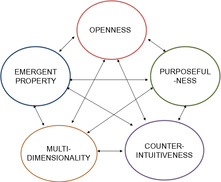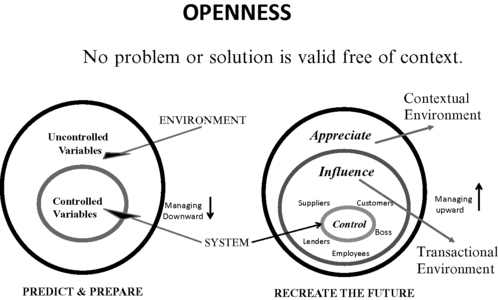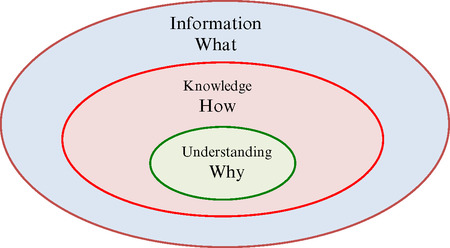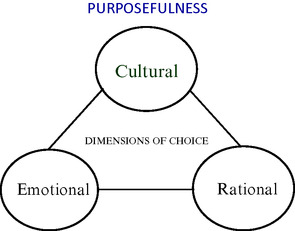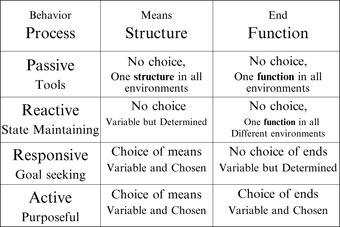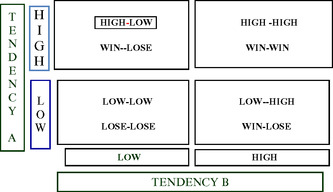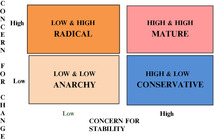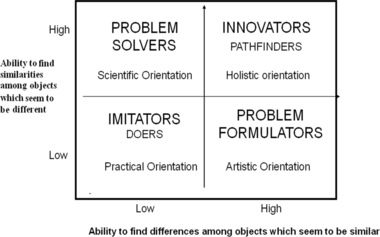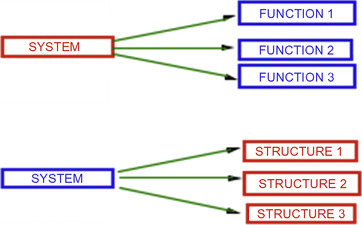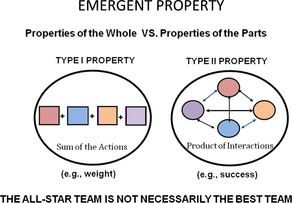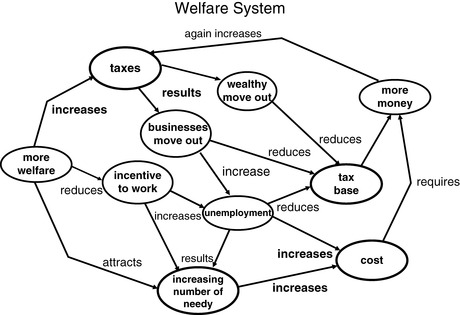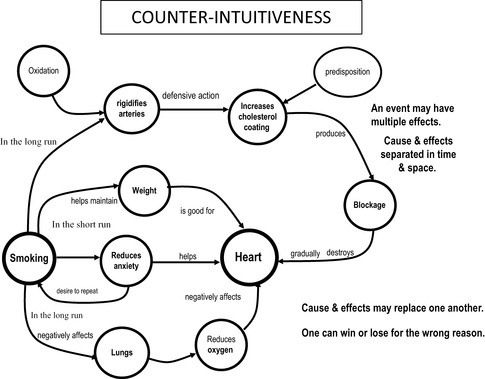Chapter Two. Systems Principles
To understand the behavioral characteristics of multi-minded systems we need a system of systems concepts. Five systems principles — openness, purposefulness, multidimensionality, emergent properties, and counterintuitive behavior — form an interactive whole that together define the essential characteristics and underlying assumptions about the nature of a sociocultural system. They are the building blocks of the mental model needed to become a systems thinker and designer.
These principles are an integral part of the third-generation systems thinking. Their implications will be present in every aspect of systems methodology, from defining problems to designing solutions. Systems methodology is impotent if isolated from the paradigm of which it is a part.
Keywords: Change of phase; chaotic simplicity; Collective memory; Complementary relationships; Contextual environment; Continuum; Contradictions; Controllable variables; Conventional wisdom; Default choice; Dichotomy; Dynamic process; Emergence; Entropy; Environmental fallacy; Equifinality; Goal-seeking systems; Influence; Multifinality; Open and closed systems; Organized complexity; Paradox; Purposeful systems; Qualitative change; Singularity point; Spontaneous outcome; State-maintaining systems; Systems boundary; Transactional environment; Typology; Uncontrollable variables; Win/win environment; Zero-sum-game
The five principles of openness, purposefulness, multidimensionality, emergent property, and counterintuitive behavior, acting together as an interactive whole, define the essential characteristics and assumptions about the behavior of an organization viewed as a purposeful, multi-minded system (Figure 2.1).
These principles are an integral part of the third-generation systems view. Their implications will be present in every aspect and in all of the subsequent parts of this work, from defining problems to designing solutions. Please read them carefully, more than once. Make them your own. Use them in different contexts so you can internalize them. They are the building blocks of the mental model you will need to construct to become a systems thinker and systems designer.
2.1. Openness
Openness means that the behavior of living (open) systems can be understood only in the context of their environment. The world is, indeed, a complex whole in interaction. Therefore, even genuine inquiries regarding human nature, such as the love of liberty, lust for power, and search for happiness, are abstractions that cannot be meaningfully entertained when separated from the context, or the culture of which they are a part.
We can observe, somewhat helplessly, that “everything” depends on “everything else,” concluding that we should not mess around with “the natural order of things” and that we may be better off leaving everything in the hands of the “One” who has control over all.
But if there are elements of chance, choice, and certainty in everything we do, we need to know which elements are certain and which ones offer the opportunity for choice. And how do we deal with the randomness of chance? Remember that appreciation of drag, a law of nature, as a certainty made it possible to convert the so-called obstruction into an opportunity and use it as an instrument of flying.
Our first break came by recognizing that although everything depends on everything else, this “everything” can be grouped into two categories: those elements that somehow can be controlled and those that cannot. This distinction gave us an operational definition of the system, environment, and system boundary.
The system therefore consists of all of the interactive sets of variables that could be controlled by participating actors. Meanwhile, the environment consists of all those variables that, although affecting the system's behavior, could not be controlled by it. The system boundary thus becomes an arbitrary, subjective construct defined by the interest and the level of the ability and/or authority of the participating actors.
Then a second break came along. We discovered that the behavior of the variables in the environment, although uncontrollable, is more or less predictable. In most cases, the less controllable a contextual variable, the more predictable it becomes.
This led to the formulation of the first rule for getting a handle on open systems: the imperatives of predict and prepare. Predicting the environment and preparing the system for it became the foundation of the neoclassical school of management. Developing the econometric model and winning the Nobel Prize brought fame and fortune to Wharton. Chase followed suit with its own model, and soon thousands of organizations were each specializing in forecasting different industries. The new game was learned and played artfully by almost all entities — large and small, business and governmental (Figure 2.2).
But success somehow changed the game. Something went wrong. In the last 10 years we have observed, with much apprehension, that all the predictions made by our prize-winning models were wrong. So much so that those who never used them were much better off than those who did. We went back to the drawing board again and this time rediscovered a whole new category of variables that we had missed the first time: those variables that we do not control but instead influence.
To control means that an action is both necessary and sufficient to produce the intended outcome. To influence means that the action is not sufficient; it is only a coproducer.
As our knowledge about the environment increased, however, so did our ability to convert the uncontrollable variables to those that could be influenced. As we increased our ability to influence a variable, we decreased our ability to predict it. If a rain dance had any influence on the weather, we would not be able to predict the weather. Ironically, the extent to which we are able to predict the weather is an indication that we might not be performing the rain dance properly.
The new category of variables, those that could be influenced, form a new region called the transactional environment. The transactional environment is becoming significant to understanding the behavior of an open purposeful system. It includes all the critical stakeholders of a system: customers, suppliers, shareholders, the boss, and, ironically, the members themselves.
Customers used to be predictable, but uncontrollable. We were told they were always right. Increasingly, they are becoming more and more susceptible to influence and therefore are less and less predictable. It seems that the nerds are taking over. The boss has become weird and unpredictable as well.
Suppliers used to be the most agreeable group. They did what they were told. Today they claim to house the core technology. Who is in control of the computer industry? It is not the big system houses like IBM that are in charge; it is the component builders, the Microsofts and Intels of the world, that have much more to say and are, in all likelihood, the ones in control.
Slowly, we are realizing that we do not actually control much of anything, but do have the ability to influence many things. I do not really know how much of me is me and how much is those I love. Managing a system is therefore more and more about managing its transactional environment, that is, managing upward. Leadership is therefore defined as the ability to influence those whom we do not control.
Open (living) systems display certain characteristics that are most significant to our understanding of their behavior. Open (living) systems not only preserve their common properties but also jealously guard their individualities. At the biological level, living systems achieve this durability through genetic coding (DNA), a blueprint for self-reproduction. Unless their genetic coding is altered, living systems go on replicating themselves almost indefinitely. The continuity of the individual and collective identities owes itself to a similar phenomenon — a tendency to create a predefined order based on an internal blueprint.
As open (living) systems, social groups such as organizations exhibit the same tendency, a movement toward a predefined order. Therefore, the cultural code becomes the social equivalent of biological DNA, those hidden assumptions deeply anchored at the very core of our collective memory. Left to be self-organized, these internal codes, by default, act as organizing principles that invariably reproduce the existing order.
In an earlier work, Theory and Management of Systems (1972), I devoted a whole chapter to the subject of chaos and order, articulating how living systems are able to reverse the formidable second law of thermodynamics and move toward complexity and order.
The second law states that a general tendency in the universe (as a closed system) is toward elimination of all differences. Thus, the ultimate state is sameness and randomness, a chaotic simplicity. Entropy (S), the measure of randomness, will therefore always increase. However, we know that living systems are neg-entropic (–S). They are able not only to negate this formidable process by differentiation, but also to move toward a predefined order, an organized complexity. Using the formula I = –S, which indicates that a neg-entropic system must have information, one might conclude that movement toward complexity and order is only possible if the system has a means of knowing and an internal image of what it wants to be. This result provided the first clue for constructing the sociocultural model, which is the subject of Chapter 3.
To summarize the major points, I have argued the following:
• Open systems can be understood only in the context of their environments.
• Leadership is managing upward; it is about influencing what one cannot control and appreciating what one cannot influence.
• Open systems, by default, are guided by an internal code of conduct (DNA or culture). If left alone, open systems tend to reproduce themselves.
2.2. Purposefulness
To influence the actors in our transactional environment we have to understand why they do what they do.
Understanding is different from both information and knowledge. Information deals with the what questions, knowledge with the how questions, and understanding with the why questions (Figure 2.3). There once was a time when having information about clients was a competitive advantage, but this is not the way it is today. To maintain a competitive position one must move to a new plateau, the knowledge level, and learn how they do what they do.
Thereafter, to be an effective player, one has to move yet higher, to the level of understanding, and learn why they do what they do.
The why question is the matter of purpose, that of choice. The choice is the product of the interactions among the three dimensions: rational, emotional, and cultural (Figure 2.4).
Rational choice is the domain of self-interest, or the interest of the decision maker, not the observer. A rational choice is not necessarily a wise choice. It reflects only the perceived interest of the decision maker at the time. Meanwhile, wisdom has ethical implications and considers the consequence of an action in the context of a collectivity.
The following examples explains this notion of choice with much more clarity. My daughter Jeyran was only five and jumping up and down on our bed. I said to her, “Jeyran, I would not do that if I were you.” Giving me an innocent look, she replied, “No, I don't think so. If you were me, you would be doing exactly what I'm doing. You don't know how exciting this is.”
When I worked for IBM, we were told, “The customer is right, always right. If you don't believe this, you will not work here. We know he's right even if we don't know why; your job is to find his rationale, and learn why he's doing what he's doing.”
Actually, in trying to find this rationale, I learned the most important lesson of my professional life: market economies, like democracies, make only rational choices. The winners are not necessarily the best, but those who are most compatible with the existing order. Being ahead of your time is sometimes more tragic than falling behind.
The story of the Ford Foundation's birth control project in India was another eye-opener for me. During a working visit to India, my senior partner, Russ Ackoff, met a number of Americans trying to teach family planning and birth control to Indians. They were not succeeding and were frustrated over the program's failure to produce any results. “Indians are irrational,” the project manager told Russ. “They know population is their number-one enemy, and here we are teaching them control, giving them all the contraceptives they need, plus a transistor radio as a reward. But look what happens. They go home, turn the radio on, and with music make a new baby.” Russ suggested that they simply could not dismiss this behavior as irrational and should be looking for other explanations. The project manager then produced a newspaper clipping in which it was reported that an Indian woman had given birth to her 27th child, adding “If this isn't irrational then I don't know what irrational is!”
Russ then posed the following: “If a woman can have 27 children, then why do Indians, on average, have only 4.6? This means they know how to practice control, but aren't willing to do so. Maybe you are solving the wrong problem.” When the issue was put in this context it was discovered that at the time, there was no social security, no retirement, and no unemployment benefits. Therefore having three sons, by default, was considered the retirement system. The first priority for each couple was to put their retirement in place. Statistically, to have three sons requires an average of 4.6 children. Not surprisingly, those who had three sons had stopped having children. Perhaps the lady in the news clipping was trying to establish her retirement as well.
Now who was irrational? The Indian couple who got a free transistor radio by attending a lecture? Or the Ford Foundation guy who thought he could get a couple to give up their retirement by giving them a transistor radio?
The emotional choice is the domain of beauty and excitement. We do lots of things because they are exciting or, more precisely, because they are challenging. If you happen to beat me 10 times in a tennis game, I do not think you will look forward to playing me again. You will probably want to play someone who can challenge you — the one, ironically, who might have a chance of beating you.
A colleague and friend at the Wharton School, Professor Aron Katselenenboigen, liked to use episodes in chess to explain interesting social phenomena. I once asked him why a majority of chess players like to play with those who are much better at the game than themselves. “It's the challenge,” he replied. “Winning is fun if it's associated with a real challenge.”
I tested this theory with 10 of my graduate students at Wharton. We had a computer program that could play chess at nine different levels. Level one was very simple. Anyone with a basic knowledge of chess could win with no difficulty. However, the higher levels posed a much greater challenge. Winning at level six, for example, required considerable mastery. Each student was told that he/she could play 10 games at any level he/she wanted; for every game won he/she would receive a dollar, and for every game lost he/she would have to give back a dollar.
All the students started at level one, but after winning a few dollars all moved to higher levels. By the finishing time most were playing at level five, and two were even at level six.
If the excitement of a good challenge were not part of our decision criteria, life would be a bore. In other words, setting and seeking attainable goals is a banal existence. This may come as a surprise to many “human resource managers,” but for sure it explains the boredom and meaninglessness associated with huge segments of corporate life.
In contrast to rational choice, which reflects on instrumental (extrinsic) values, the emotional dimension deals with stylistic (intrinsic) values. It is the enjoyment and satisfaction derived from the emotional state in and of itself. While rational choice is risk aversive, emotional choice is not. Risk is an important attribute of excitement and challenge.
Culture defines the ethical norms of the collectivity, of which the decision maker is a member. The ethical values are the constraining elements of the decision process. However, by dictating the default values, culture has a profound impact on the decision process. Just like a high-level computer language that provides default parameters when the programmer fails to choose one, the culture provides default values when actors fail to choose one explicitly.
Purposeful systems are value-guided systems; in other words, values are what purposeful behaviors strive to achieve. More often than not, these values are implicit in the culture, and the decision maker is not even aware that she/he has a choice. Default values are usually treated as realities out there; and they will remain out there as long as no one is willing to challenge them.
Finally, the essence of purposefulness can be appreciated only by understanding the distinctions that Ackoff makes between the three types of system behavior: reaction, response, and action. A reaction is a system behavior for which an event in the environment is both necessary and sufficient. Thus a reaction is an event that is (deterministically) caused by another event. A response is a system behavior for which an event in the environment is necessary but not sufficient. Thus a response is an event of which the system itself is a coproducer. An action is a system behavior for which a change in the environment is neither necessary nor sufficient. Actions, therefore, are self-determined events, or autonomous behavior.
Reactive, responsive, and active systems are, in turn, correlated with state-maintaining, goal-seeking, and purposeful systems (Table 2.1).
A state-maintaining system is one that reacts to changes to maintain its state under different environmental conditions. Such a system can react (not respond) because what is done is determined entirely by the change in its environment, given the structure of the system. Nevertheless, it performs an intrinsic function by maintaining its state in a different way under different conditions. For example, many heating systems are state-maintaining. An internal controller turns the system on when the room temperature goes below a desired level, then turns it off when the temperature goes above this level. The state maintained is the room temperature. Such a system is able to adapt to change but is not capable of learning, because it cannot choose its behavior. It cannot improve with experience.
A goal-seeking system is one that can respond differently to different events in the same or a different environment until it produces a particular outcome (state). Production of this state is its goal. Such a system has a choice of means but not of ends; hence it is responsive rather than reactive. Response is voluntary; reaction is not. For example, lower level animals can seek food in different ways in the same or a different environment. If a goal-seeking system has memory it can learn to pursue its goal more efficiently over time.
A purposeful system is one that can produce not only the same outcomes in different ways in the same environment but also different outcomes in both the same and different environments. It can change its ends under constant conditions. This ability to change ends under constant conditions is what exemplifies free will. Such systems not only learn and adapt; they can also create. Human beings are examples of such systems.
Purposeful systems have all the capabilities of goal-seeking and state-maintaining systems. Meanwhile, goal-seeking systems have the capabilities of state-maintaining systems, although the converse is not true.
Finally, it is reasonable to assume that decision implies power. And power is a concept of many meanings and dimensions. However, according to Boulding (1968), it may be defined as the amount of change created in a future state by a decision. Since doing nothing is always an option, the power of a decision maker can be measured by the difference in the future state between doing something and doing nothing.
A concept closely related to that of power is freedom, which also has many meanings and dimensions. One meaning is that of an alternative, or a range of choices. If I have no alternatives, I am clearly not free to choose; therefore I have no power to change the future state.
This brings us to the next discussion: the principle of multidimensionality.
2.2.1. Recap
• The world is not run by those who are right. It is run by those who can convince others they are right.
• Choice has three aspects: rational (self-interest), emotional (excitement), and cultural (default).
• While rational choice is risk averse, emotional choice is not. Risk is an important attribute of excitement and challenge.
• Realities out there will remain out there as long as no one is willing to challenge them.
• Choice is a matter of competence; it implies power-to-do. Liberty without competence is an empty proposition.
2.3. Multidimensionality
Multidimensionality1 is probably one of the most potent principles of systems thinking. It is the ability to see complementary relations in opposing tendencies and to create feasible wholes with infeasible parts.
1Throughout this book I use dimensions to identify quantifiable variables and also to reflect aspects and facets of a system.
For the majority of cultures, a fallacy has dominated the treatment of opposing tendencies as a duality in a zero-sum game. Everything seems to come in a pair of opposites: security/freedom, order/complexity, collectivity/individuality, modernity/tradition, art/science, and so on. They are cast in such a way that a win for one is invariably associated with a loss for the other.
In the context of a zero-sum game, opposing tendencies are formulated in two distinct ways. First, conflicting tendencies are conceptualized as two mutually exclusive, discrete entities. The conflicts are treated as dichotomies that are usually expressed as X or NX (Figure 2.5). If X is right then NX has to be wrong. This represents an or relationship, a win/lose struggle with a moral obligation to win. The loser, usually declared wrong, is eliminated.
Second, opposing tendencies are formulated in such a way that they can be represented by a continuum (Figure 2.6). Between black and white are a thousand shades of gray. This calls for a compromise, or resolution of the conflict. Compromise is a frustration point, a give-and-take struggle. Depending on the relative strength of the poles of tension, the power game will come to a temporary halt. The compromise point is an unstable mixture, usually containing elements of two extremes. As the power structure changes, so does the compromised position.
The constant struggle between groups of people who see different “clear and urgent” necessities when dealing with social realities — the urgency of production versus that of distribution, the desire to protect the rights of victims versus the rights of the accused, the need to protect the environment versus the individual right to make a living — is the manifestation of a need to develop new frameworks.
Churchman's (1979) concern with the “environmental fallacy,”Boulding's (1968) rejection of suboptimization (1968), and Ackoff's (1978) concept of “separately infeasible parts making a feasible whole” are reflections of the same concern.
It seems as though we live in an age of paradoxes. Even time-honored values such as freedom and justice are not spared. Boulding (1953) acknowledged the dilemma with the observation that some are afraid of freedom, seeing always behind it the specter of anarchy, whereas some others are afraid of justice, seeing always behind it the specter of tyranny.
Furthermore, consider the relation between security and freedom. One cannot be free if one is not secure; one will not be secure if one is not free. Maybe freedom, justice, and security are three aspects of the same thing and were not meant to be separated in the first place. Certainly, treating them in isolation has been problematic.
A complement is that which fills out or completes a whole. The principle of multidimensionality maintains that the opposing tendencies not only coexist and interact, but also form a complementary relationship. The complementary relationship is not confined to pairs. More than two variables may form complementary relations as the trio of freedom, justice, and security demonstrates (see Figure 2.7).
The mutual interdependence of opposing tendencies is characterized by an and instead of an or relationship. This means that each tendency is represented by a separate dimension, resulting in a multidimensional scheme where a low/low and a high/high, in addition to low/high and high/low, are strong possibilities.
This is a non-zero-sum formulation in which a loss for one side is not necessarily a gain for the other; on the contrary, both opposing tendencies can increase or decrease simultaneously.
Using a multidimensional representation, one can see how the tendencies previously considered as dichotomies can interact and be integrated into something quite new. The addition of new dimensions makes it possible to discover new frames of reference in which opposing sets of tendencies can be interpreted in a new ensemble with a new logic of its own.
Says Churchman (1979): “The usual dichotomy of ‘x’ or ‘not x’ never seems to display the general, because neither of the above is always so prominent an aspect of social systems.”
Note that in classical logic, contradictions are relative to a domain; adding a new dimension expands the domain and converts the contradictions to complementaries.
To explain this further, let us look at a related concept: typology. A proper way of developing typologies, which corresponds with my intentions here, requires that the relevant variables, which together define the state of the phenomenon under study, are identified and each conceptualized as a separate dimension.
A dimension represented by an arrow is used to reflect a quantification of a variable on a given scale. It measures a characteristic specified by the operational definition of the variable involved. Segmentation of this scale into two regions of low and high is usually based on an assumption that the low or high value assigned to the variable will have a significant impact on the behavior of the system that is coproduced by the variable.
In this context, the point of distinction between low and high is not arbitrary (Figure 2.8). It signifies the level at which the behavior of the dependent system is qualitatively affected. This is a change that corresponds to the singularity or inflection point (change of phase) in physical phenomena.
In other words, if the variable income has an impact on an individual's behavior, there seems to be a critical level of income at which a change in lifestyle occurs, qualitatively affecting that behavior.
If I make $10 a week, I may eat one hamburger; with $20 I may have two; and with $30 I will try three. However, if I make $1,000 a week, I will not eat 100 hamburgers. I may not eat hamburgers at all. Therefore, a quantitative change in my income at some point has produced a qualitative change in my way of life. That is the point of distinction between the low and the high level of income.
Provided one is aware of their underlying assumptions and limitations, typologies can show how behavior of a multidimensional system differs significantly according to the emphasis on one or the other dimension.
For example, the interaction of a high concern for change with a high concern for stability produces a completely different mode of behavior than the one produced either by a high concern for change coupled with a low concern for stability or the one produced by a high concern for stability coupled with a low concern for change (see Figure 2.9).
The high/high represents the behavior of a mature system, searching for stability through change. While the low/high reflects a radical system interested in change at any price, it can be reactionary or progressive, depending on the direction of the change sought. The high/low, on the other hand, represents a conservative state, preferring the status quo and, therefore, a tendency for regulation and compromise. But the low/low is anarchy with a low concern for change and a low concern for stability, opposed to government in any form.
Therefore, with different combinations of the levels of concern (low or high), different modes of behavior will emerge. Each mode represents a new system whose character can be understood only in its own right.
The typology of the management style developed by Blake and Mouton (1964) underscores the same point by demonstrating that although the “1.9” and “9.9” styles both reflect a high concern (9) for people, the manifestations of these concerns are different in both cases (Figure 2.10).
The 1.9 is a paternalistic, populist leader, whose concern for people is basically a concern for their weaknesses. Therefore, he/she assumes a protective role. Meanwhile, the 9.9 is a leader whose main concern for people stems from a respect for their ability and individuality. He/she assumes a different role — that of a motivator.
In the work of Gerald Gordon and colleagues (1974) that studies the factors conducive to innovation, we see the following two abilities as complementary to an individual's propensity to innovate: the ability to differentiate between objects that seem similar and the ability to find similarities between seemingly unrelated matters (Figure 2.11).
Similarly, we can show how seemingly contradictory requirements for order and complexity are simultaneously achieved by an organization, and the requirement for stability and change is achieved with adaptation. In each case, the desired characteristic would not be a compromise, but a new totality with characteristics of its own.
2.3.1. Plurality of Function, Structure, and Process
Complementary to the principle of multidimensionality and parallel to it is the concept of plurality. Plurality of function, structure, and process, as we will see later on, is at the core of systems theory of development. It makes the high/high a possibility and choice a reality. Plurality simply maintains that systems can have multiple structures and multiple functions and be governed by multiple processes (Figure 2.12); it denies the classical view of a single structure with a single function in a single cause-and-effect relationship.
2.3.1.1. Plurality of function
A system can have multiple functions, both implicit and explicit. A car, for example, in addition to having the explicit function of transportation, might have an implicit function of, say, an identification tag. For many, a car defines the lifestyle of its owner and can have considerable snob value.
Furthermore, an investor might consider a car company a money-making machine, while union leaders see it as job-producing system. For an entrepreneur, the organization may present a lifetime challenge to create a winning system; however, for a professional corporate citizen it might be the platform for an internal power game. Indeed, organizations have multiple functions, generating and disseminating wealth, power, and beauty. Still, corporate actors, depending on their mindsets or the roles assigned to them, consider only one of these functions as primary. This is the fallacy that results in successful operations but dead patients.
2.3.1.2. Plurality of structure
Earlier, we proposed that the system's structure defines the components and their relationships. Plurality of the structure, therefore, means that the components and the relationships among them are multiple and variable.
Consider, for example, salt (NaCl). Its components — chlorine (Cl) and sodium (Na) — form a single type of relationship in all environments; therefore, salt is said to have a singular structure. But the same cannot be said about hydrocarbons. Hydrogen and carbon enter into various combinations and relationships, resulting in multiple structures. Carbon's ability to combine with itself gave rise to a whole new branch of evolution (the biological systems), creating unstable but steady-state structures.
Human beings display a similar tendency. They form varying relationships with each other, creating an interactive type of structure, or a social system. Interactions between purposeful actors in a group take many forms. Social actors may cooperate on one pair of tendencies, compete over others, and be in conflict over different sets, all at the same time. In addition, members of a social system learn and mature over time and are therefore variable and subject to change. The result is an interactive network of variable members with multiple relationships, re-creating itself continuously. This is what is meant by the plurality of structure.
Acceptance of plurality of structure, unlike that of functions, is a difficult proposition, since it goes against the traditional concept of structure as something that endures. However, a reconceptualization of this traditional concept is necessary to appreciate the principle of purposefulness and multidimensionality.
2.3.1.3. Plurality of process
The classical principle of causality maintained that similar initial conditions produce similar results, and consequently that dissimilar results are due to dissimilar initial conditions. Therefore, for a given structure, behavior of the system is completely predictable and its future states invariably depend on its initial conditions and the laws that govern its transformation (determinism).
Bertalanffy (1968), in analyzing the self-regulating or morphostatic features of open biological systems, loosened this classical belief by introducing the concept of “equifinality”: a final state may be reached by any number of different developmental routes. Buckley (1967), in his discussion of morphogenetic processes in sociocultural systems, goes even further and suggests an opposite principle, “multifinality”: similar initial conditions may lead to dissimilar end states. So the process, rather than the initial conditions, is responsible for future states. Accordingly, a social phenomenon can also be studied as the end result of a set of interactive processes. This adds a new dimension to the process of inquiry, which is key for understanding a powerful concept: the emergent property.
2.3.2. Recap
• “With infeasible parts you can create a feasible whole.”2
2For demonstration of this beautiful conception see The Art of Problem Solving (Ackoff (1978)).
• In a multidimensional scheme, differences in degrees are differences in kind. A “high/high” concern represents a different behavior from a “low/high” concern. Each mode has its own distinct interpretation for the meaning of the variables involved.
• Freedom, justice, and security, in my belief, are three aspects of the same thing. They should not be separated; treating them in isolation has always been problematic.
2.4. Emergent property
I can love, but none of my parts can love. If you take me apart, the phenomenon of love will be lost. Furthermore, love does not yield itself to any one of the five senses. It does not have a color, a sound, or an aroma. It cannot be touched or tasted. Then how does one measure love? Of course one may always measure the manifestation of love. “If you love me why don't you call me?” someone may say.
Something does not seem quite right. The phenomenon of love does not fit the classical description of a property. Furthermore, it does not seem to be alone in this distinction. Similar phenomena, such as success, failure, and happiness, display the same types of characteristics. So let us give them a name, emergent properties, and put them in a category of their own: type II properties, as distinct from the more classical type, which we will call type I properties (Figure 2.13).
Emergent, or type II, properties are the property of the whole, not the property of the parts, and cannot be deduced from properties of the parts. However, they are a product of the interactions, not a sum of the actions of the parts, and therefore have to be understood on their own terms. Furthermore, they do not yield to any one of the five senses and cannot be measured directly. If measurement is necessary, then one can measure only their manifestation.
Emergent properties, by their nature, cannot be analyzed, they cannot be manipulated by analytical tools, and they do not yield to causal explanations. Consider the phenomenon of life, the most significant emergent property. No one has yet been able to identify a single cause for life. Falling into the trap of trying to find correlation, we could probably find one between life and almost everything. Unfortunately, these correlations do not explain much about the essence of life. Relying exclusively on an analytical approach, not surprisingly, fails to produce a basic understanding about emergent properties.
I have suggested that emergent properties are the product of interactions among several elements. The mere notion of interaction signifies a dynamic process producing a time-dependent state. In other words, the emergent phenomenon is reproduced continuously online and in real time.
Therefore, life, love, happiness, and success are not one-time propositions; they have to be reproduced continuously. If the processes that generate them come to an end, the phenomena cease to exist as well. They cannot even be stored or saved for future use. And for sure, none can be taken for granted. Life, love, and happiness can be there one moment and gone the next. The same is true of success; it is just as vulnerable as love and happiness.
If emergent properties are the spontaneous outcome of ongoing processes, then to understand them one has to understand the processes that generate them. Dying is very natural; staying alive is the miracle. It takes simultaneous interactions among hundreds of processes to keep someone alive. Those who try to explain the phenomenon of life as a single accident do not know what they are talking about.
If success is an emergent property, then it has to be about managing interactions rather than actions. An all-star team is not necessarily the best team in the league, and it might even lose to an average team in the same league. What characterizes a winning team is not only the quality of its players but also the quality of the interactions among them. A few years ago the New Orleans Saints football team had four defensive players in the Pro Bowl, but that did not mean the Saints had the best defense in the league. The same year, the Dallas Cowboys won the Super Bowl, without having any defensive players in the Pro Bowl.
The compatibility between the parts and their reinforcing mutual interactions creates a resonance, a force, which will be an order of magnitude higher than the sum of the forces generated by the separate parts.
On the other hand, incompatibility among the parts will result in a less potent force than what the aggregate would have been able to produce. In the same way, an organization, depending on the nature of the interactions among its members, can be a value-adding or value-reducing system.
I have argued elsewhere that an organization's success is the product of the interactions among the five basic processes of throughput, decision making, learning and control, membership, and conflict management. These processes correspond with generating and disseminating wealth, power, knowledge, beauty, and values.
For example, to understand the success of GE, one cannot simply look at its earnings and market shares. At any given time, one might win or lose for the wrong reasons. Understanding GE's organizational processes (specifically decision, learning, and measurement systems) may provide a better explanation for its continuous success.
We have said that emergent properties cannot be measured directly; one can measure only their manifestations. However, measuring the manifestation of a phenomenon has proven very problematic.
For example, if the number of phone calls is the measure of love, then one can fake it. People can call people without necessarily loving them.
Since most of the behavioral characteristics of living systems are type II properties, the art of faking has been the major preoccupation of behavioral sciences in recent decades. How one can pretend to be something that one is not has been the money-making question of our times. Consider the huge market for how-to books, which give advice on a multitude of topics such as how to come across as a caring person when one does not care at all. Remember when one could pretend to be powerful simply by wearing a red tie?
Measuring the success of an organization has not been an easy proposition, either. As the manifestation of success, growth has been considered an important performance measure of an organization. If an organization is successful, most probably it will grow; however, if an organization is growing, this does not necessarily mean that it is successful. One can easily grow by “faking,” or making lousy acquisitions. But unfortunately, two turkeys will not make an eagle. And that is exactly how many organizations have grown, only to destroy themselves.
To avoid pitfalls in measuring an emergent property, one has to measure more than one manifestation. In this context, economic value added (EVA) is a much more reliable measure of past success than simple growth.
EVA is based on two important manifestations of success. It is the product of both growth and value generation over and above the cost of capital. A positive EVA indicates a value-adding growth, while a negative EVA shows a value-reducing one.
Finally, manifestation of a phenomenon in its totality can be assessed only by picturing the future implicit in the present behavior of a given system. To map this future, we need a handle on social dynamics.
2.4.1. Recap
• Instead of trying to describe a property only in terms of being, we can also try to understand it as a process of becoming.
• An all-star team is not necessarily the best team in the league, and it might even lose to an average team in the same league. What characterizes a winning team is not only the quality of its players but also the quality of the interactions among them.
• The compatibility between the parts and their reinforcing mutual interactions creates a resonance, or force, which may be an order of magnitude higher than the sum of the forces generated by the parts separately.
• Emergent properties are the spontaneous outcome of ongoing processes. Life, love, happiness, and success are not one-time propositions; they have to be reproduced continuously. If the processes that generate them end, the phenomena will also cease to exist.
2.5. Counterintuitive behavior
Social dynamics is fraught with counterintuitive behavior. It stands on a level of complexity beyond the reach of analytical approach.
Counterintuitive behavior means that actions intended to produce a desired outcome may generate opposite results. It has been said that the path to hell is paved with good intentions. Things can get worse before getting better, or vice versa. One can win or lose for the wrong reason.
Making drugs illegal, while costing the nation a fortune, was meant to curb abuse and save the society from its ills. Counterintuitively, it has produced a multi-billion-dollar crime industry, higher consumption, and an overburdened criminal justice system.
To appreciate the nature of counterintuitive behavior, one needs to understand the practical consequences of the following assertions:
• Cause and effect may be separated in time and space. An event happening at a given time and place may have a delayed effect, producing an impact at a different time and a different place.
• Cause and effect can replace one another, displaying circular relations.
• An event may have multiple effects. The order of importance may shift in time.
• A set of variables that initially played a key role in producing an effect may be replaced by a different set of variables at a different time. Removing the initial cause will not necessarily remove the effect.
Expanding the welfare system to reduce the number of poor families in a community may, counterintuitively, increase their numbers. Improvement of welfare usually requires additional resources, which means an increase in taxes. Excessive taxation may push the wealthy and many businesses to move out of the region, diluting the tax base and reducing revenues.
Moreover, a more attractive welfare system will attract higher numbers of the needy to the region. It may also reduce the incentive to work, adding the burden of unemployment to an already overloaded system. Increased cost, coupled with reduced revenue, becomes a recipe for disaster (Figure 2.14).
For example, to examine the total effects of smoking on the heart, we should consider its multiple outcomes. Smoking might reduce anxiety and therefore, in the short term, be beneficial to the heart. In addition, smoking, by reducing excessive desire to eat, helps maintain body weight, also helping the heart. But the pleasure associated with reduced anxiety is habit-forming and results in a desire to repeat the act. However, in the long run, smoking has a negative effect on the arteries. Combined with genetic dispositions and/or other oxidizing processes, smoking results in rigidity, roughness, and hardening of the heart's arteries. The natural defenses of the body react with multiple layers of cholesterol coatings to smooth things out, which ultimately results in a blockage and heart attacks.
Furthermore, smoking negatively affects the functioning of the lungs, resulting in a less-than-optimum supply of oxygen to the heart (Figure 2.15). In this context, it seems that developing a simple correlation between variables does not mean much; it might even be misleading. Is cholesterol the real villain or just an element of an overprotective defensive mechanism?
We have said that multifinality negates the classical principle of causality, suggesting that process, using different combinations of certainty, chance, and choice rather than the initial condition, is mostly responsible for future states.
All this means that understanding the short- and long-term consequences of an action, in its totality, requires building a dynamic model to simulate the multi-loop, nonlinear nature of the system. The model should capture the critical time lags and relevant interactions among major variables.
This approach is distinctly different from the conventional one, where the fallacy of generating simple correlation is responsible for proliferating misinformation that is floated around continuously. Considering the level of confusion that exists around counterintuitive outcomes, it is not difficult to see how one might attribute them to the chaotic nature of the universe.
Ironically, an interesting formulation known as chaos theory (Gleick, 1987) provides an alternative insight into the nature of this phenomenon. Unpredictability of nonlinear systems parallels counterintuitive behavior in a social context.
Chaos theory was advanced by a group of scientists3 with different backgrounds (in physics, chemistry, and mathematics) working on the dynamics of complex physical phenomena. It seemed, at first, that chaos theory is but a systems theory of fluid dynamics. But I found it to be very relevant to the problems of social dynamics and a welcome addition to the realm of systems thinking. It adds a new, somehow twisted perspective to the notion of complexity and holistic thinking.
Chaos theory, using a different perspective, reconfirms the significance of the Herculean work done by Ackoff (1972), some 40 years ago, in explaining the behavioral characteristics of purposeful systems. The work essentially provides the basic tools and concepts needed to understand choice and why social systems do what they do. There is another reason for my interest in chaos theory. Recognition of the fundamental role iteration plays in the discovery of complex patterns is very compatible with my long-held belief that iteration is the essence of the holistic approach, and the core element of the design methodology (for details, see Part Three).
The following is my take on the relevant and interesting points of chaos theory:
• Analyzing the behavior of a nonlinear system is like walking through a maze whose walls rearrange themselves with each step you take (in other words, playing the game changes the game).
• Systems too complex for traditional mathematics could yet obey simple laws, for example, fractal geometry4 and fuzzy logic. 5
4For anyone interested, the original, indispensable source is The Fractal Geometry of Nature (Mandelbrot, 1977).
5For definition and description see Fuzzy Sets and Applications (Zadeh, 1987).
• Laws of complexity hold universally across hierarchical scales (scalar, self-similarity) and are not influenced by the detailed behavior of constituent parts.
• We are less likely to be able to explain the behavior of a complex whole by studying the behavior of the parts; contrarily, we are more likely to be able to explain the behavior of the parts by studying the behavior of the whole.
• A new understanding of time brings the realization that time is not really defined by the clock but by rhythms and iterations. 6
• “Nature forms patterns, some orderly in space but disorderly in time, others orderly in time but disorderly in space. Some patterns are fractal, exhibiting structures self-similar in scale, while others oscillate” (Gleick, 1987, p. 308).
Four kinds of attractors determine the nature of the patterns:
1. Point attractor (drawn to or repelled from a particular activity)
2. Cycle attractor (oscillation between two or more activities)
3. Torus attractor (organized complexity repeating itself)
4. Strange attractor (unpredictable complex patterns emerging over time)
If one is tempted to use chaos terminology in the social context, the four attractors, viewed from a systems perspective, can be explained as follows. The point attractors represent the behavior of social beings in pursuit of their natural instincts — fear, love, hate, desire to share, or self-interest. The cycle attractors (dialectic/self-maintaining) would correspond to our principle of multidimensionality, pursuit of seemingly opposite but complementary tendencies: stability and change, security and freedom, and, in general, differentiation and integration. Cyclicality, or periodic shift of emphasis from one orientation to another, is the result of suboptimization. Torus attractors (equifinal/neg-entropic/goal-seeking) exemplify the behavior of open systems. These systems are guided by the image (DNA) of what they ought to be, as growth patterns of biological systems. Strange attractors (multifinal/self-organizing/purposeful) reflect the behavior of sociocultural systems with choices of ends and means; unpredictable patterns emerge out of stylistic preferences of purposeful actors.
Note that self-organization is not always a conscious act. More often than not, it happens by default or through a random iterative process of deviation amplification (evolution). Therefore, self-organization, if it happens by default using implicit cultural codes, would be more like the patterns produced by a torus attractor. However, redesign would be the type of self-organization created by a strange attractor.
Ackoff's (1972) description of passive, reactive, responsive, and active systems corresponds beautifully to the behavioral patterns attributed to the four attractors previously listed. (See Section 2.2 earlier in this chapter.)
With attractors, it is the iteration that makes it possible for order to appear from chaos. Nature automatically creates the iteration, but social beings can return to zero only by choice to start a new iteration. Designing from a clean slate is a reflection of this imperative.
Counterintuitive behavior of social systems is further exemplified by the following observations:
1. Social systems display a tendency to repeat themselves and reproduce the same set of non-solutions all over again.
One can never overestimate the resistance to change. “Conventional wisdom is like an old guard; it would rather die than surrender.” A comfort level with the familiar, combined with fear of the unknown, creates a formidable force that may even override potential self-interest. People may genuinely become excited by a beautiful idea and even support it wholeheartedly. But as the idea moves closer to implementation, insecurity and self-doubt set in. The supporters of the idea may then subconsciously sabotage their own efforts and prevent the change. Along with this comes pathological behavior, which is produced when those in charge of removing an obstruction benefit from it. Absent the support of a courageous, charismatic leader who enjoys the confidence of his/her people, any suggestions for a fundamental change become potentially self-destructive propositions. The fool who chooses to take on this role should be aware of his/her eventual loneliness.
2. A difference in degree may become a difference in kind.
A commonly accepted principle of systems dynamics is that a quantitative change, beyond a critical point, results in a qualitative change. Accordingly, a difference in degree may become a difference in kind. This doesn't mean that an increased quantity of a given variable will bring a qualitative change in the variable itself. However, when the state of a system depends on a set of variables, a quantitative change in one variable beyond the inflection point will result in a change of phase in the state of the system. This change is a qualitative one, representing a whole new set of relationships among the variables involved. Suppose my style of life (state of a system) depends on my income. If my income were to suddenly change from $1,000 a month to $100,000 a month, it would certainly change my style of life. The change, of course, would be a qualitative one, representing a new mode of being. The income level that brings a qualitative change in lifestyle may be different for different people; however, it defines a critical juncture called the inflection point as defined above.
Catastrophe theory (Zeeman, 1976), which deals with the same phenomena but in a physical context, reveals that at the inflection point, systems display catastrophic behavior (a cusp). In the social context, an inflection point will usually occur when one of the critical variables changes by an order of magnitude, that is, when something can be done 10 times faster, cheaper, and/or better than would have been possible before.
In his book Only the Paranoid Survive (1996), Andrew S. Grove, President and CEO of Intel Corporation, dealt beautifully with the change of phase in a modern, technology-driven corporation. He explains, with great insight, how a “10X” change in certain variables (such as technology, markets, and regulations) resulted in a “strategic inflection point” and a change in the nature of the business, where the known facts of the business become invalid and a whole new set of emotions — denial, fear, insecurity, and feeling of betrayal — sets in.
3. I have mentioned before that market economies, like democracies, do not usually select the best solutions. They choose the most compatible, satisficing solution. Being ahead of your time is sometimes more tragic than falling behind.
The following episode, used by Grove to indicate the impact of a 10X change in the marketplace, demonstrates, in my opinion, the essence of market economies' counterintuitive behavior as well.
Steve Jobs, co-founder of Apple, is arguably the founding genius of the personal computing industry. He left Apple in 1985 to create the “Next” generation of superbly engineered hardware, a graphical user interface that was even better than Apple's Macintosh interface, and an operating system much more advanced than Mac. The software would be built in such a way that customers could tailor applications to their own uses by rearranging chunks of existing software rather than having to write it from the ground up. He wanted to create a computing system that would be in a class by itself. Jobs did not like PCs. He thought them inelegant and poorly engineered. The irony is that he was right. It took him a few years, but the Next computer and operating system delivered basically on all its objectives.
Yet while Jobs was working on his “insanely great computer,” Microsoft Windows had come on the market. Windows wasn't even as good as the Mac, let alone the Next interface, and it wasn't seamlessly integrated with computers or applications. But it was cheap and it worked, most importantly, on the inexpensive personal computers that by the late 1980s were available anywhere in the world from hundreds of PC manufacturers.
Grove, 1996, pp. 59–60
The Next machine, even with all its beauty, never took off. Despite an ongoing infusion of cash, a state-of-the-art software operation, and a fully automated factory built to produce a large volume of Next computers, Jobs could not overcome the widespread momentum generated by the combination of Microsoft Windows and Intel Pentium chips, known figuratively as “WinTel.” Ironically, Microsoft owes as much of its success to Intel as Intel owes to Microsoft. Each one, by default, created a 10X market for the other.
It is also worthy to note that the Next machine and its operating system is now the basis for the popular and very successful Apple computers and Apple X Operating System.
4. Passive adaptation to a deteriorating environment is a road to disaster.
It's been said that if a frog is suddenly dropped into boiling water it will immediately jump out. However, if you put the same frog in warm water that is heated gradually, the frog will boil to death with no objection. The same is true of social systems. The capacity to adapt gradually to a changing environment can lead to a disaster if the adaptation is to a deteriorating environment. That only one of the original companies in the Dow Jones index participated in its centennial celebration is an indication that death, even among successful organizations, is more common than we like to believe. In fact, gradual deaths are more common than sudden deaths. In what is called the “Pan Am Syndrome,” organizations bleed to death by adapting to an imperceptible gradual change, always doing too little too late. Ironically, sudden change of phase with all of its ramifications is less dangerous than imperceptible, gradual change. An organization facing a sudden change may still have enough organizational strength left in it to cope. But in the case of passive adaptation, by the time an organization recognizes the severity of the problem, it may have already lost most of its strength and be unable to do anything about it.
2.5.1. Recap
• Success in playing the game changes the game, and tenacity in playing the old game converts success to failure.
• Market economies, like democracies, make only rational choices. The winners are not necessarily the best, but those most compatible with the existing order. Being ahead of your time is sometimes more tragic than falling behind.
• Cause and effect display circular relations. Events have multiple effects, each with a different time lag and independent life of its own.
• Removing the cause will not necessarily remove the effect.
• Nature's tendency for iteration, pattern formation, and creation of order out of chaos creates expectations of predictability. It seems, however, that nature, because of varying degrees of interaction between chance and choice, and the nonlinearity of systems, escapes the boredom of predictability.
..................Content has been hidden....................
You can't read the all page of ebook, please click here login for view all page.

